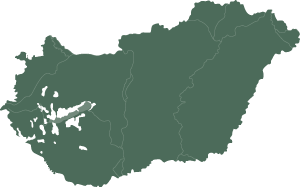Personal opinion:
The 2012 vintage is peculiarly charming and robust. This year pronouncedly helped the Budai Zöld variety- the acids that are sharp anyway became even fuller. This is the wine I consider most appropriate to consume a spritzer with added soda water (which I don't see as a crime!) It is an expressedly masculine, summer refreshment.
Gastronomical pairing:
I would most recommend it as a spritzer, it is worth trying,
I would at most recommend it with crackling or cheese scone.
What is a spritzer? In Hungary, mostly in older times some wines were heartily consumed with added soda water. They most often used the dilution ratios of 2 parts wine and 1 part soda water for the small spritzer and 1:1 for the big spritzer. Personally I have heard of some 22 varieties. Various ratios were often given nicknames.
For example: mason, janitor, stiff, lantern etc.
About the Budai Zöld or “Budai Green” variety:
The Budai Zöld is a Hungarian white wine grape variety. It developed in the Carpathian Basin, and received its name after the Buda region vines.
It used to be a popular variety but its production site was reduced by the expansion of the capital and the agglomeration. Since the phylloxera epidemic it is mostly characteristic in the Badacsony wine region. In 1941 it was used when the new vines were planted in the Badacsony-Balatonfüred-Csopak wine region.
Its yield is abundant, its clusters are big, packed with an average weight of 160 grams; its berries are medium-sized, slightly elongated, greenish yellow or greenish white and slightly dotted. It is sensitive to rotting and frost. It ripens late, and can be harvested in the second half of October.
It is the stamen variety of the Kéknyelű - there are many similarities in the wines of the two varieties.
Its wine is hard, crisp, dry quality white wine.
The region and its history:
In the Badacsony area, vines were grown in Roman times, and Emperor Probus had sizeable plantings here. At the time of the settlement of the Magyars in Hungary they already knew about vines and wine. They appreciated areas capable of growing vine. A significant part of the wine region was taken over by the church in the 13th century. In the 18th-19th century the Badacsony vermouth gained a similar reputation to that of the Tokaj aszú in Europe.
During the reconstruction after the phylloxera epidemic, supporting walls were built to prevent soil erosion. New varieties also entered the area. The Szürkebarát was introduced from France by monks. Due to the special soil content it evolved into a typical local variety, the Szürkebarát, which botrytises in good years.
The variety grown in the biggest amount is Olaszrizling that is in better years ripened on the stock longer, and is used to make ice wine or late-harvest hand-selected Olaszrizling. Szürkebarát, Tramini, Sárga muskotály, Rajnai rizling and Chardonnay are also present on the larger lands.
Kéknyelű or " Blue Stem" used to be a characteristic wine of the region. It was significantly confined by the frost damage of the 1980's but is experiencing a revival today, and will be an emblematic wine of the Badacsony region again in the near future.
Badacsony wines are typically full-bodied, fiery, aromatic and mineralized. Traditional wine-making and maturation in wooden barrels are characteristic. Although reductive wine-making and other modern technologies are also spreading, they have not significantly changed the character of the region's wine, yet.
Climate and geography:
Badacsony is the highest mountain in the Tapolca Basin; it stands between two bays of Lake Balaton. The circumference of the almost round mountain is 11km, the diameter of its top region slightly elongated in the north-south direction is 1-1.5km, its highest point is 437.4 metres above sea level. Its hillside is covered up to 280 metres by various loose deposits that are excellent for growing vine, and its soil is basalt-based loess. It is covered by various loose deposit, Pannon clay and Pannon loess, above which there are basalt rocks.
Its climate is mild and balanced with high humidity. Because of the proximity of Lake Balaton the southern hills can also enjoy the sunshine reflected from the surface of the water, therefore there is a very beneficial microclimate that makes the making of natural dessert wine possible.
The wine region includes the vine cadastre-based first and second class border sections of the following settlements: Ábrahámhegy, Badacsonytomaj, Badacsonytördemic, Balatonrendes, Balatonszepezd, Diszel, Gyulakeszi, Hegymagas, Káptalantóti, Kisapáti, Kővágóörs, Nemesgulács, Raposka, Révfülöp, Salföld, Szigliget, Tapolca.
NAME: SÉZA
YEAR: 2012
VARIETY: Budai Zöld/Budai Green
WINE REGION: Badacsony
CLASS: Dry white wine with protected designation of origin
Product of Hungary
Bottle volume: 750ml
Alc. 12%vol
Contains sulphites


